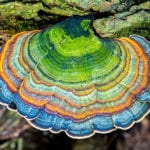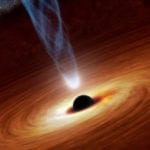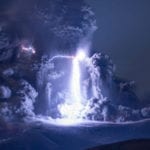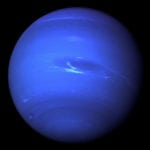 Movies and TV
Movies and TV  Movies and TV
Movies and TV  History
History 10 Things You Didn’t Know About the American National Anthem
 Technology
Technology Top 10 Everyday Tech Buzzwords That Hide a Darker Past
 Humans
Humans 10 Everyday Human Behaviors That Are Actually Survival Instincts
 Animals
Animals 10 Animals That Humiliated and Harmed Historical Leaders
 History
History 10 Most Influential Protests in Modern History
 Creepy
Creepy 10 More Representations of Death from Myth, Legend, and Folktale
 Technology
Technology 10 Scientific Breakthroughs of 2025 That’ll Change Everything
 Our World
Our World 10 Ways Icelandic Culture Makes Other Countries Look Boring
 Misconceptions
Misconceptions 10 Common Misconceptions About the Victorian Era
 Movies and TV
Movies and TV The 10 Coolest Stars to Set Sail on The Love Boat
 History
History 10 Things You Didn’t Know About the American National Anthem
 Technology
Technology Top 10 Everyday Tech Buzzwords That Hide a Darker Past
Who's Behind Listverse?

Jamie Frater
Head Editor
Jamie founded Listverse due to an insatiable desire to share fascinating, obscure, and bizarre facts. He has been a guest speaker on numerous national radio and television stations and is a five time published author.
More About Us Humans
Humans 10 Everyday Human Behaviors That Are Actually Survival Instincts
 Animals
Animals 10 Animals That Humiliated and Harmed Historical Leaders
 History
History 10 Most Influential Protests in Modern History
 Creepy
Creepy 10 More Representations of Death from Myth, Legend, and Folktale
 Technology
Technology 10 Scientific Breakthroughs of 2025 That’ll Change Everything
 Our World
Our World 10 Ways Icelandic Culture Makes Other Countries Look Boring
 Misconceptions
Misconceptions 10 Common Misconceptions About the Victorian Era
Top 10 Bizarre New Weather-Related Phenomena
For generations, weather has been a staple of both humor and comedy. Mark Twain wrote that The Adventures of Huckleberry Finn was his attempt to write a book without any weather in it. The “weather forecast for tonight,” comedian George Carlin said, was, in a word, “dark.” And writer Charles Dudley Warner noted that “everybody talks about the weather, but nobody does anything about it.”
Despite such witticisms, weather—in general, an effect of wind and sun (on Earth, at least)—is vital to our welfare and, indeed, our very existence, and it is taken so seriously, by farmers, researchers, and almost everyone else, that a whole branch of knowledge, meteorology, is dedicated to its study.
Although we tend to think that the weather offers little that is unknown to us, new meteorological phenomena, as well as weather-related phenomena, do occasionally occur. As this list shows, some of them are truly bizarre, and a few are literally out of this world. Relatively recent discoveries include new types of clouds, new types of extremely powerful storms, an odd optical phenomenon, an unsuspected origin of droughts, hurricane “fuel,” solar flare eruptions’ effects on magnetic fields, the existence of space hurricanes, the so-called Green Ghost, an unexpected source of antimatter, and “a whole different thing.”
10 Conspiracy Theories About Weather Modification
10 Mammatus Clouds
Although they were first witnessed in the early twentieth century, mammatus clouds were added to the World Meteorological Organization’s classification system only in its 2017 update of The International Cloud Atlas.
Named for their resemblance to cows’ udders, mammatus clouds form upside-down, hanging, as it were, from the undersides of cirrocumulus, altostratus, altocumulus, and stratocumulus clouds. Many believe that mammatus clouds herald the approach of a tornado, but they don’t necessarily indicate severe weather, despite their tendency to accompany thunderstorms.
Mammatus clouds form when moist, cool air sinks into drier, warmer air. When the moisture they contain consists of large drops of water vapor or crystals of snow, the clouds tend to last longer than they would otherwise, because it takes longer for the vapor to evaporate, since there is more of it. There is no mistaking these clouds; their appearance is strikingly unusual, even rather eerie.
9 Steve
What’s purple; appears in the sky like a gigantic, unraveling ribbon; and may or may not be a new type of aurora?
A group of amateur meteorologists, The Aurora Chasers, who first spotted the phenomenon named it Steve, in honor of the name that the children in the movie Over the Hedge give the previously unknown creature they discover.
The Aurora Chasers’ discovery interested Eric Donovan, a University of Calgary professor, who knew that the discoverer’s assumption that Steve was a proton aurora wasn’t correct, since proton auroras are always invisible, being “typically too dark to be seen.” Donovan determined that “as [a] satellite flew straight though Steve, data from [an] electric field instrument showed very clear changes,” including an increase in temperature at an altitude of “300 km (186 miles) above the Earth’s surface.” The atmosphere heated up “by 3000 degrees Celsius (5432 degrees Fahrenheit) and . . . a 25 km-wide (15 mile) ribbon of gas [flowed] westwards at about 6 km/s compared to a speed of about 10 m/s either side of the ribbon.”
Steve wasn’t as rare as was first believed. In fact, Steve was “very common,” although the phenomenon “had gone unnoticed” before The Aurora Chasers spotted it. One of the amateur scientists who discovered Steve suggested that its name, as an acronym, perfectly describes its origin: “Strong Thermal Emission Velocity Enhancement.” However, Donovan and his colleague Bea Gallardo-Lacour weren’t certain what accounts for Steve, although they planned to publish their findings after conducting additional research.
It’s a good thing that Donovan and Gallardo-Lacour didn’t commit prematurely to a theory of Steve’s origin, because their additional research revealed the fact that Steve is not an aurora, after all. Steve did not result from “showers of rain [from] the Earth’s upper atmosphere,” as auroras do. Instead, the phenomenon is “a kind of skyglow,” its source of origin unknown, which makes the light in the night sky “a new kind of optical phenomenon,” Donovan and Gallardo-Lacour concluded. Next, they plan to determine whether Steve owes its existence to events in the ionosphere or to those at a higher level of the Earth’s atmosphere.
8 Stormquakes
As their name suggests, stormquakes, a new geophysical phenomenon, are produced by the gigantic forces of the planet’s weather.
Hurricanes and other intense storms can cause vibrations in the floor of the ocean. These stormquakes are as powerful as those of a minor earthquake (3.5 on the Richter scale). Wenyuan Fuan, an assistant professor of Earth, Ocean and Atmospheric Science at Florida State University, and his research team found that intense storms transfer some of their tremendous energy to Earth’s crust, or outer layer, by way of the powerful waves the storms generate. This energy, in turn, produces “intense seismic source activity” that can last from hours to days.
Fuan and his team found that over 10,000 stormquakes occurred in the ocean floor, along the edges of the planet’s continental shelves, off New England, Florida, the Gulf of Mexico, Nova Scotia, Newfoundland, and British Columbia.
7 Landfalling Droughts
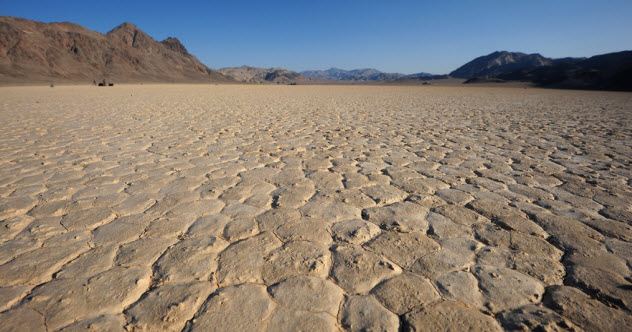
Landfalling droughts begin at sea, but travel onto land, where they give rise to conditions even “larger and drier” than those cause by other types of drought. Their discovery gives meteorologists hope that they may be able to predict the approach of such droughts as surely as they do the day’s weather. Such predictions are likely, Stanford University scientists claim, which is good news, indeed, since one of every six of the droughts that occurred between 1981 and 2018 were landfalling droughts.
Droughts cause a host of problems, including crop failure, reductions in water supply, lower production of electricity, adverse effects regarding trade and the health of the ecosystem, population displacement, and losses of billions of dollars. The team’s discovery that landfalling droughts occur in regions characterized by “atmospheric pressure patterns” that elevate arid conditions could allow meteorologists to track them as they “migrate” toward land, which “usually take[s] . . . months,” thereby allowing “advance warning” that could permit some protection against the phenomena and their effects.
6 Surfactants’ Effects on Sea Spray
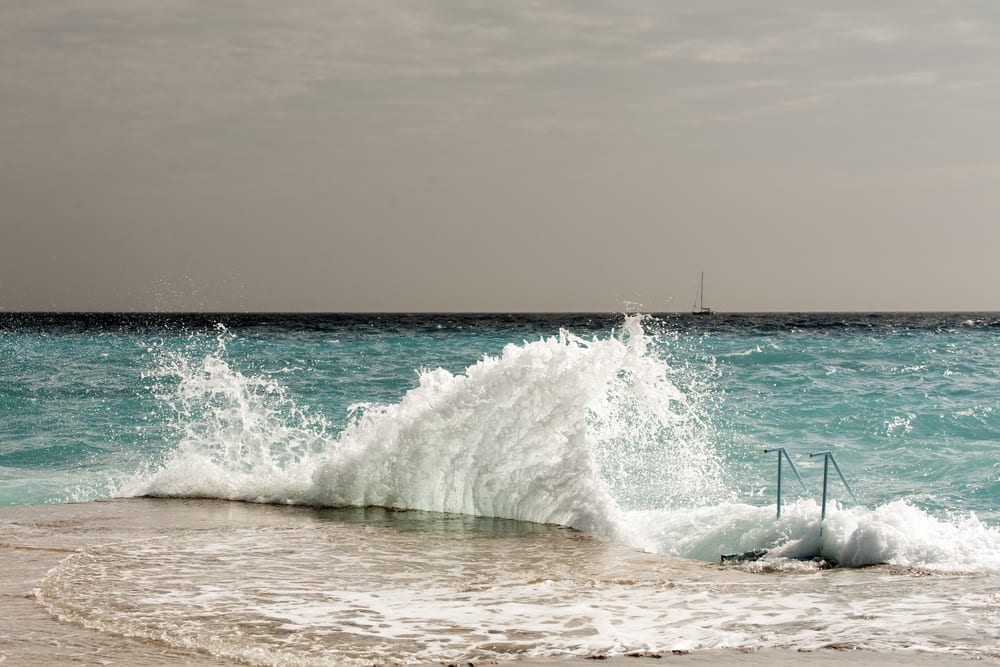
Another recently discovered meteorological phenomenon might allow forecasters to sound the alarm in advance of the arrival of hurricanes. An article by a research team associated with Nova Southeastern University’s Halmos College of Arts and Sciences and Guy Harvey Oceanographic Research Center pinpoints two problems that impede hurricane predictions: the rapid rates at which these storms intensify and decline.
One of the paper’s authors, NSU Halmos College Ph.D. student Breanna Vanderplow, said that, when environmental conditions are favorable, surface-active biological materials, such as coral reefs, and surface-active anthropogenic materials, such as oil spills, can enlarge sea spray “distribution,” serving as a sort of “’fuel’ for hurricanes,” thus intensifying the storms and their effects.
Alexander Soloviev, Ph.D., a professor, and principal investigator at NSU’s Halmos College’s Department of Marine and Environmental Sciences, explained how biological and anthropogenic surfactants effect such changes in hurricanes: “Surfactants reduce interfacial tension between air and water, which results in an increased rate of sea spray generation. . . . Evaporating sea spray is part of tropical cyclone thermodynamics. Spray particles also produce additional resistance to the air-low since they increase the total surface exposed to the wind.”
Prior to the team’s discovery of the role that such surfactants play in the intensification of hurricanes, these materials were believed to affect only the thermodynamics of tropical cyclones. “Breanna has identified a new phenomenon which may contribute to improving hurricane intensity forecasts,” Soloviev said.
5 Solar Flare Phenomenon
Not all weather happens on Earth. Other planets have their share. Weather even occurs in space. Indeed, much of the solar system’s weather results from the sun’s energy.
The current 3-D model regarding solar flares suggests that such flares occur in “distorted” areas of the sun’s magnetic field. In these areas, the magnetic fields form loops that “slip and flip around each other,” reconnecting. As they do so, the fields create new magnetic structures, and magnetic energy increases until it is released, as the loops, or field lines, “straighten,” resuming their previous “lower energy states.”
The eruptions, known as Corona Mass Ejections (CMEs), discharge magnetic energy into space on a tremendous scale. Now that its creation is predictable, due to the verification of the 3-D model regarding solar flares, scientists’ ability to predict the occurrence of solar flares is likely to help protect technology, aircraft, satellites, infrastructure, and the Earth itself from the effects of highly destructive “space weather.”
In discussing the implications of the the understanding of the solar flare phenomenon, Dr. Jaroslav Dudik, a Royal Society Newton International Fellow at the University of Cambridge’s Centre for Mathematical Sciences, summarized the benefits that such knowledge should bring: “Human civilisation is nowadays maintained by technology and that technology is vulnerable to space weather.”
4 Space Hurricanes
High above Earth’s polar regions, vortexes of plasma spin like hurricanes. But hurricanes, polar or otherwise, don’t occur only on Earth; they form over the solar system’s other planets as well and, indeed, across the universe.
As particles rise or fall, a low-pressure zone forms. Hurricanes tend to appear around these zones. Just as tropical storms form this way in the lower reaches of Earth’s atmosphere, so do space hurricanes gather around electrically charged particles in the ionosphere. Space hurricanes are a lot bigger than those on the Earth or the solar system’s other hurricanes, though; plasma whirling at a distance of hundreds of kilometers above the Earth’s North Pole has measured 1,000 kilometers, or 600 miles, across, and electrons, accelerating away from the plasma storms, hurtle toward the Earth, “enhancing the northern lights,” which themselves also “take a cyclonic shape.”
Scientists believe that a calm before the storm actually creates space hurricanes. When the Earth’s magnetosphere is relatively inactive, the planet’s magnetic field lines remain undisturbed, “funneling electrical particles from the solar wind . . . into the upper and middle atmosphere,” where the solar storms created by such funneling can interrupt satellite transmissions. At the same time, the “continuous flux” of solar particles gradually erodes technology, even when space weather is fairly calm.
3 Green Ghost
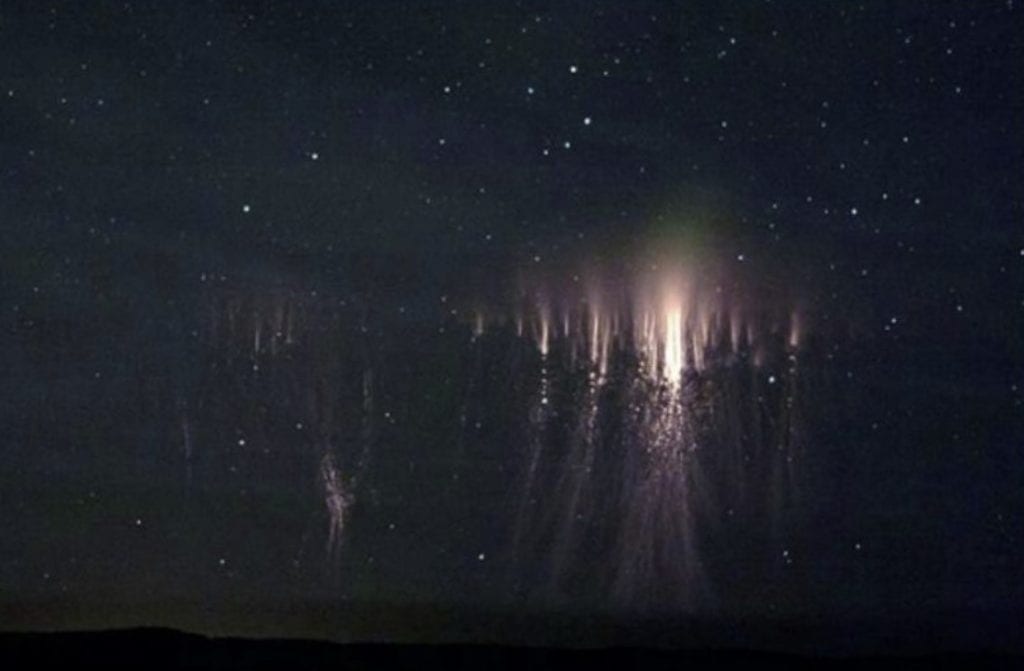
Transient luminous events are phenomena that occur above thunderstorms. Such events are known by exotic names, such as sprites, trolls, elves, and pixies. In 2020, Thomas Ashcraft discovered a new one: the Green Ghost. He videotaped two of them as they appeared in the sky above west Texas. Ashcraft also saw their origin: they “were generated by strong peak current lightning strokes.”
Aschcraft is one of the few who have witnessed the phenomenon, but he wasn’t the first to do so. That honor belongs to Hank Schyma, a Houston Texas, storm chaser whose handle is Pecos Hawk. As he reviewed footage he shot in Oklahoma, he saw “green afterglow above some of the larger sprites,” he said. When he and fellow storm chaser Paul M. Smith shared their video of the phenomenon with scientists, many of the experts argued that the phenomenon was nothing more than “a camera sensor artifact.” The scientists’ skepticism didn’t prevent Smith from photographing more ghosts, however, and more and more scientists became convinced that the Green Ghosts were real.
Although no one knows what causes the ghosts, their color may offer a clue, since auroras and airglow often display green colors as a result of the excitation of their oxygen molecules. The same cause may produce the colors of the Green Ghosts; hence their name. If nothing else, the unusual phenomenon suggests that the weather and its related effects remain mysterious, even after thousands of years of investigation.
2 Antimatter
Thunderstorms produce even more energy than we knew. In the mid-1990s, researchers discovered that lightning and the electrical fields above such storms produce gamma radiation that can be detected from space. These gamma-ray flashes (GRFs) occur across the Earth, as many as five-hundred times each day. And that’s not all thunderstorms produce. NASA’s Fermi Gamma-ray Space Telescope has revealed other, until recently “undetected[,] phenomena”: tops of thunderstorms also produce antimatter beams!
The antimatter beams pack quite a wallop: 511 keV, the energy equivalent to “an electron-positron annihilation event.” According to scientists, when conditions are right, powerful electrical fields atop thunderstorms can produce an inverted “avalanche of electrons” which attains near-light speed. When these accelerated electrons “bounce off air molecules,” they release high-energy gamma rays, the TGFs, that can trigger the telescope’s sensors.
1 “A Whole Different Thing”
Saturn’s weather has produced an odd, but interesting, weather phenomenon: a Great White Spot that “raged near the planet’s north pole in 2018.” It’s the third type of storm astronomers have witnessed on the giant heavenly body. One of the other two types includes smaller storms of 2,000 kilometers (approximately 1,250 miles) across, which resemble “bright clouds” and last for a few days. The other known type, the planet’s Great White Spots, which are “10 times as large [as the smaller storms,] can rage for months.” The source of all three types of storms is the same, scientists believe: clouds of water “hundreds of kilometers below the planet’s upper cloud cover.”
The newly discovered type of Saturn’s storms remains something of a mystery. It is unknown how much lightning it generates or how it is formed, although some astronomers believe that it is a remnant of “a failed Great White Spot.” Planetary scientist Robert West isn’t convinced by this possible explanation, however. The gases in Saturn’s atmosphere, which are alleged to fuel the Great White Spots, tend not to mix, he says. The newly discovered type of storm isn’t likely to be a failed Great White Spot, as some of his colleagues believe, West said, but “a whole different thing,” the origin of which remains, for now, unknown.
Top 10 Crazy Stories Of Weather Modification
About The Author: An English instructor at the University of Nevada Las Vegas, Gary L. Pullman, a regular contributor to Listverse, lives south of Area 51, which, according to his family and friends, explains “a lot.” His five-book series, An Adventure of the Old West, is available on Amazon.
